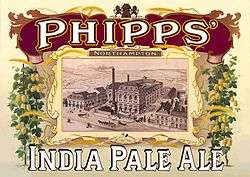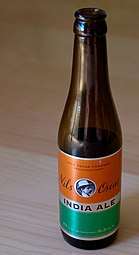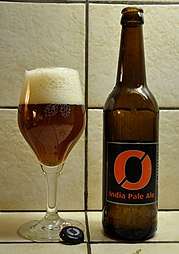India pale ale
India pale ale (IPA) is a hoppy beer style within the broader category of pale ale.[1][2]
| India pale ale | |
|---|---|
.jpg) Hardcore IPA from BrewDog | |
| Country of origin | United Kingdom |
| Alcohol by volume | 4.5% - 17.2% |
| Color (SRM) | 6 - 14 |
| Bitterness (IBU) | 25 - 120 |
| Original gravity | 1.050 - 1.090 |
| Final gravity | 1.000 - 1.025 |


.jpg)
The export style of pale ale, which became known as India pale ale, was developed in England around 1840, and later became popular there and worldwide.[1][2][3][4]
History
The pale ales of the early eighteenth century were lightly hopped and quite different from today's pale ales.[5] By the mid-eighteenth century, pale ale was mostly brewed with coke-fired malt, which produced less smoking and roasting of barley in the malting process, and hence produced a paler beer.[6][7] One such variety of beer was October beer, a pale well-hopped brew popular among the landed gentry, who brewed it domestically; once brewed it was intended to cellar two years.[8]
Among the first brewers known to export beer to India was George Hodgson's[9] Bow Brewery, on the Middlesex-Essex border. Bow Brewery beers became popular among East India Company traders in the late eighteenth century because of the brewery's location near the East India Docks[lower-alpha 1] and Hodgson's liberal credit line of 18 months. Ships transported Hodgson's beers to India, among them his October beer, which benefited exceptionally from conditions of the voyage and was apparently highly regarded among its consumers in India.[11] Bow Brewery came into the control of Hodgson's son in the early nineteenth century,[lower-alpha 2] but his business practices alienated their customers. During the same period, several Burton breweries lost their European export market in Russia when the Tsar banned the trade, and were seeking a new export market for their beer.[10]
At the behest of the East India Company, Allsopp's brewery developed a strongly-hopped pale ale in the style of Hodgson's for export to India.[12][13] Other Burton brewers, including Bass and Salt, were eager to replace their lost Russian export market and quickly followed Allsopp's lead. Perhaps as a result of the advantages of Burton water in brewing,[lower-alpha 3] Burton India pale ale was preferred by merchants and their customers in India, but Hodgson's October beer clearly influenced the Burton brewers' India pale ales.
Brewer Charrington's trial shipments of hogsheads of "India Ale" to Madras and Calcutta in 1827 proved successful and a regular trade emerged with the key British agents and retailers: Griffiths & Co in Madras; Adam, Skinner and Co. in Bombay and Bruce, Allen & Co. in Calcutta.[14]
Early IPAs like Hodgson's, and those produced by the Burton brewers, were only slightly higher in alcohol than most of the other beers brewed in their day and would not have been considered strong ales; however, a greater proportion of the wort was well-fermented, leaving behind few residual sugars, and the beer was strongly hopped.[15] The common story that early IPAs were much stronger than other beers of the time, however, is a myth.[16] While IPAs were formulated to survive long voyages by sea better than other styles of the time, porter was also shipped to India and California successfully.[17] It is clear that by the 1860s, India pale ales were widely brewed in England, and that they were much more attenuated and highly hopped than porters and many other ales.[18]
Demand for the export style of pale ale, which had become known as India pale ale, developed in England around 1840 and India pale ale became a popular product in England.[3][4] In 1837, Hodgson's IPA typically cost 6s 6d for a dozen pint bottles, the same as Guinness Double Stout, and significantly more than the 4s 3d a dozen for a Porter beer.[19] Some brewers dropped the term "India" in the late nineteenth century, but records indicated that these "pale ales" retained the features of earlier IPAs.[20] American, Australian, and Canadian brewers manufactured beer with the label IPA before 1900, and records suggest that these beers were similar to English IPA of the era.[21][22]
IPA style beers started being exported to other colonial countries, such as Australia and New Zealand, around this time with many breweries dropping the 'I' in 'IPA' and simply calling them Pale Ales or Export Pales. Many breweries, such as Kirkstall Brewery, sent large quantities of export beer across the world by steam ship to auction off to wholesalers upon arrival.
In the late 20th century, during the craft beer revolution in the United States, brewers began seeking out old beer styles that had fallen out of vogue; Ballantine IPA, which had been made in the U.S. since 1890 until the 1990s, proved inspirational.[2] The traditional IPA style was well-suited to model the intense flavor and aroma of American hops.[2] Bert Grant of Yakima Brewing and Malting identified that Cascade and Chinook hops, grown locally in Yakima, Washington, provided strong flavors when showcased in an IPA.[23][2] The boom in popularity for IPA as a style spread down the west coast of the United States, then across the United States and eventually the world.[2]
As the Oxford Companion to Beer notes: "IPA is now the signature of craft brewers worldwide. Fittingly for an export beer, brewers from Australia to Scandinavia are creating new beers, mostly inspired by the American take on the style, but often adding a regional twist of their own."[2]
United Kingdom
India Pale Ale, or IPA, has been used to describe a well-hopped, high-gravity beer since 27 August 1829 when an advertisement was placed in the Sydney Gazette and New South Wales Advertiser.[24] It gained popularity in the British domestic market after 1841,[25] and the term is still commonly used, as in Greene King IPA and Charles Wells Eagle IPA.
Worthington's White Shield is a rare example of a historic India Pale Ale, first brewed in 1829 principally for export to the British Empire. By the 1960s White Shield had become a cult drink brewed in small quantities for a dedicated following, but it found renewed popularity in the early 1970s when the demand for real ale grew in the UK.[26][27]
In the 21st century, IPA is one of the most popular beer styles in the UK.[28] In 2019, Brewdog's Punk IPA was the country's best selling craft beer in the on-trade[29] and Swannay's Muckle IPA won overall craft keg gold in SIBA's Independent Beer Awards.[30]
United States

.jpg)
In the United States, sales of IPAs have increased, helping drive the craft beer renaissance.[34] In 2019 across all craft beer sales, IPAs account for the largest percentage of any style, at 31.5%.[35]
As such, IPAs frequently top the lists of several beer awards annually. For example, Bell's Brewery's Two-Hearted Ale has been awarded the "Best Beer in America" for three consecutive years starting in 2017; in years prior, Two-Hearted Ale often placed second after another IPA, Pliny the Elder, a double IPA brewed by Russian River Brewing Company.[36] The most awarded IPA to date is Goose Island IPA, with 6 medals.[37]
Contemporary American IPAs are typically brewed with distinctively American hops. The most popular American hops are Citra, Cascade, Simcoe, Mosaic, and Centennial.[38] Within the broad category of the American IPA, several sub-styles exist.
Black IPA
Black IPA (also known as Cascadian Dark Ale (CDA) or American Black Ale), is not pale in colour. Black IPAs share the bitter hoppy flavours of their IPA cousins; however, the use of roasted malts gives them a much darker malty flavour. Greg Noonan of Vermont Pub & Brewery created the first black IPA for sale on draught only in the pub in the early 1990s, but it didn't become popular in the United States until 2009.[39]
Brut IPA
A crisp, dry IPA, the Brut IPA was invented by Kim Sturdavant, head brewer at San Francisco's Social Kitchen and Brewery.[40][41] To make a brut IPA, brewers add the enzyme amyloglucosidase to remove sugars.
Double IPA
Double IPAs (also referred to as Imperial IPAs) are a stronger, very hoppy variant of IPAs that typically have alcohol content above 7.5% by volume.[42] The style is claimed to have originated with Vinnie Cilurzo, currently the owner of Russian River Brewing Company in Santa Rosa, California, in 1994 at the now-defunct Blind Pig Brewery in Temecula, California.[43]
New England IPA
New England IPAs (also referred to as Hazy IPA or Juicy IPA) are a style of IPA invented by The Alchemist's John Kimmich with his beer, Heady Topper.[44] They are characterized by juicy, citrus, and floral flavours, with an emphasis on hop aroma with low bitterness. They also have a smooth consistency or mouthfeel, and a hazy appearance. These characteristics are achieved using a combination of brewing techniques, including the use of particular strains of yeast, the timing of adding the hops, and adjusting the chemistry of the water.[45][46][47][48] The style has become popular among New England brewers. New England IPAs need not be brewed in New England.[49] It was officially recognized as a separate beer style, the Juicy or Hazy India Pale Ale, by the Brewers Association in 2018.[50][51] A variation on the style is the milkshake IPA, which adds lactose to make a New England IPA more creamy.[52]
Triple IPA
Triple IPAs are characterized by higher hop flavours and higher alcohol content, with alcohol content usually over 10% ABV. The style is personified by Russian River Brewing Company's Pliny the Younger.[53]
West Coast IPA
West Coast IPAs are known for being low in malt content, very clear, and dry with a focus on the hops.[53]
Gallery of India pale ales

Great Divide
Titan IPA_(cropped).jpg)
Lagunitas
IPA
Bell's
Two Hearted Ale.jpg)

Fuller's
India Pale Ale_(cropped)_(cropped).jpeg)
Dogfish Head
120 Minute IPA
Nils Oscar
India Ale
Nøgne Ø
India Pale Ale
Footnotes
- The Bow Brewery was on the banks of the River Lea near Bow bridge. The East India Docks lay two miles down river.[10]
- Mark Hodgson died in 1810, leaving the Bow Brewery in the care of a trust. His only surviving son, Frederick Hodgson, took control of the brewery in 1819.[10]
- The water of Burton on Trent contains a very high concentration of sulphate which accentuates the bitterness of beer. See Daniels, Foster, and Cornell.
See also
References
- "A history of the authentically global beer". The Economist. ISSN 0013-0613. Retrieved 2020-04-11.
- The Oxford companion to beer. Oliver, Garrett. New York: Oxford University Press. 2012. p. 485. ISBN 978-0-19-536713-3. OCLC 706025045.CS1 maint: others (link)
- Daniels 1996, p. 155
- Cornell 2008, p. 104
- Anonymous 1744, pp. 72–73
- Foster 1999, p. 13
- Daniels 1996, p. 154
- Cornell 2008, pp. 97–98
- "How the India Pale Ale Got Its Name". Smithsonianmag.com. Retrieved 6 November 2017.
- Pryor, Alan (2009). "Indian Pale Ale: an Icon of Empire" (PDF). Commodities of Empire Working Paper (13). ISSN 1756-0098. Retrieved 17 February 2015.
- Cornell 2008, p. 98
- Foster 1999, p. 26
- Cornell 2008, p. 102
- Mathias 1959, p. 190.
- Foster 1999, pp. 17–21 discusses the hopping rate; Daniels 1996, p. 154 discusses the high level of fermentation.
- Foster 1999, p. 21
- "IN THE ROOM THE STORY OF ANCHOR IPA™". Anchor Brewing Blog. Anchor Brewing Company. Retrieved 28 April 2014..
- Daniels 1996, p. 156
- WANDSWORTH IN THE FIELDS. In thorough." Times, 15 June 1837, p. 2. The Times Digital Archive
- Foster 1999, p. 65
- Daniels 1996, pp. 157–58
- Cornell 2008, p. 112
- Messer, Text, Photos and Memorabilia courtesy of Ryan. "Bert Grant: The Godfather of Craft Brewing". Yakima Herald-Republic. Retrieved 2020-04-11.
- "Classified Advertising". The Sydney Gazette and New South Wales Advertiser (NSW : 1803 - 1842). NSW: National Library of Australia. 27 August 1829. p. 3. Retrieved 12 April 2020.
- "IPA: the executive summary". Zythophile.co.uk. 31 March 2010. Retrieved 6 November 2017.
- Fort, Matthew (22 September 2007). "Vintage beers". The Guardian. Retrieved 12 April 2020.
- Jackson, Michael (29 August 1992). "Drink the beer, swallow the tonic". The Independent. Retrieved 12 April 2020.
- Moyle, Nick; Hood, Richard (27 September 2017). "10 best IPAs". Independent. Retrieved 2020-05-23.
- Stone, Stuart (26 November 2019). "BrewDog Punk IPA sales increase by 19.7%". Morning Advertiser. Retrieved 2020-05-23.
- Society of Independent Brewers. Gloucester, Swannay, and Wibblers Brewery take overall UK Gold. Retrieved 23 May 2020
- Craft Beer and Brewing. Ballantine IPA.
- "Hops variety information - USA Hops.org". www.usahops.org. Archived from the original on 2009-06-29. Retrieved 2009-11-28.
- Kegerator.com. Cascade Hops: The Variety that Launched a Craft Beer Revolution.
- "Is IPA responsible for the growth of the craft beer industry? - Beer News". Beer News. Retrieved 2016-01-31.
- "2019 Beer Report: Emerging styles, flavors help craft beer". www.bevindustry.com. Retrieved 2020-04-12.
- Manzullo, Brian. "Bell's Two Hearted Ale named best beer in America — again". Detroit Free Press. Retrieved 20 October 2019.
- "Goose Island IPA most awarded IPA by Great American Beer Festival". Goose Island. Retrieved 2019-03-31.
- "The big cost of more hops: How the 2019 hop harvest shows the challenges of adding acreage". Craft Brewing Business. 2020-02-14. Retrieved 2020-04-12.
- "Let's Talk Beer Styles: Black IPA". pastemagazine.com. 2016-04-20. Retrieved 2020-04-12.
- Fabricant, Florence (2018-12-21). "Meet Brut I.P.A." The New York Times. ISSN 0362-4331. Retrieved 2020-04-12.
- "The Birth of the Brut IPA". Craft Beer & Brewing. Retrieved 2020-04-12.
- "American Double IPA" Archived 2014-12-07 at the Wayback Machine Beer Advocate. Retrieved 30 May 2013.
- Hernandez, Brandon (2018-05-21). "Vinnie Cilurzo of Russian River Brewing". The Beer Connoisseur. Retrieved 2020-04-12.
- "The 'Haze Craze': Beer Lovers' Newfound Obsession With Murky IPAs". NPR.org. Retrieved 2020-04-12.
- Alström, Jason; Alström, Todd (May 2017). "It's Official: New England India Pale Ale Is a Style". Beer Advocate. Retrieved 6 November 2017.
- Noel, Josh (5 July 2017). "How I learned to stop worrying and love hazy IPA — some hazy IPA". Chicago Tribune. Retrieved 25 November 2017.
- Moorhead, John (August 2016). "New England IPA: The Haze Craze". American Homebrewers Association. Retrieved 25 November 2017.
- Sparhawk, Andy (2 August 2017). "The New England Style IPA Is the Anti-IPA". CraftBeer.com. Retrieved 25 November 2017.
- Stein, Jason (8 June 2017). "The Haze Craze: 11 Breweries Outside of New England Making NE IPAs". Paste Magazine. Retrieved 25 November 2017.
- "New England-Style, Hazy Ales Finally Get Industry Recognition". 20 March 2018.
- "Brewers Association Beer Style Guidelines". Brewers Association.
- "What Exactly Is a Milkshake IPA? • Hop Culture". Hop Culture. 2020-01-20. Retrieved 2020-04-12.
- "Your guide to 5 IPAs: Decoding the different styles of this hop-intensive beer". Los Angeles Times. 2014-02-22. Retrieved 2020-04-12.
Bibliography
- Anonymous (1744). The London and Country Brewer. London: Thomas Astley. OCLC 22476249. OL 24190346M.CS1 maint: ref=harv (link)
- Cornell, Martyn (2008). Amber, Gold & Black: The Story of Britain's Great Beers. Zythography Press.CS1 maint: ref=harv (link)
- Daniels, Ray (1996). Designing Great Beers: The Ultimate Guide to Brewing Classic Beer Styles. Brewers Publications. ISBN 978-0-937381-50-2.CS1 maint: ref=harv (link)
- Foster, Terry (1999). Pale Ale: History, Brewing Techniques, Recipes (Second ed.). Brewers Publications. ISBN 978-0-937381-69-4.CS1 maint: ref=harv (link)
- Jackson, Michael (1978). The World Guide to Beer. Ballantine Books. ISBN 978-0-345-27408-3.CS1 maint: ref=harv (link)
- Mathias, Peter (1959). The Brewing Industry in England 1700-1830. CUP Archive. GGKEY:DYD5N29F6JD.CS1 maint: ref=harv (link)
Further reading
- Brown, Pete (2009), Hops & Glory: One Man's Search for the Beer That Built the British Empire, Pan Macmillan
- Steele, Mitch (2012). IPA: Brewing Techniques, Recipes, and the Evolution of India Pale Ale. Brewers Publications. ISBN 978-1-938469-00-8.
External links
